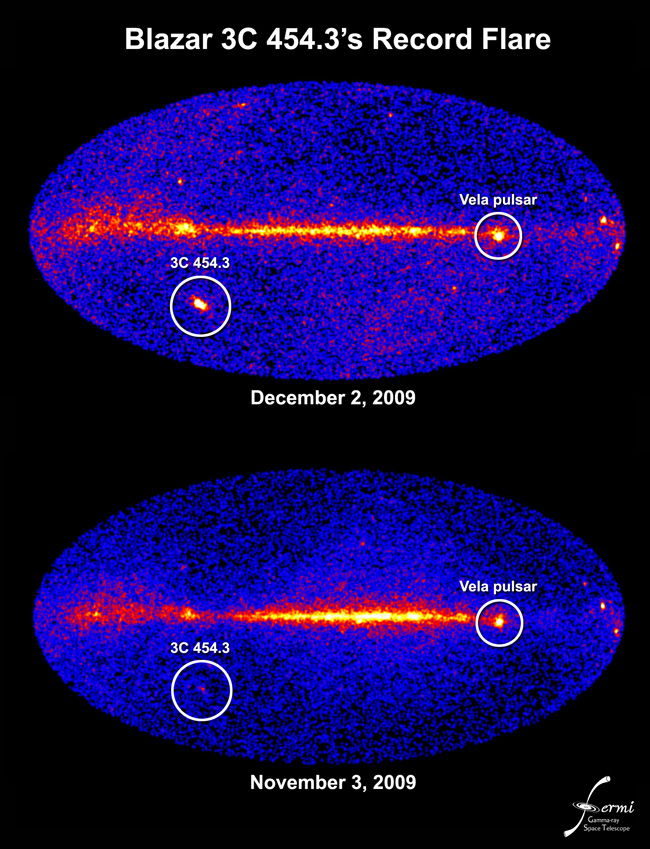Brightest Gamma-Ray Flare in Universe Spotted

A distant galaxy with a giant black hole in its center hasbeen acting up recently, emitting extremely bright flashes of gamma ray light.
The flares began Sept. 15, making the galaxy currently thebrightest source of gammarays in the sky and boosting its own brightness to more than 10 times its regularluminosity over the summer. NASA's Fermi Gamma-ray Space Telescope has beenobserving the phenomenon to learn more about how such active galaxies work.Astronomers think this galaxy, identified as 3C 454.3, is what'scalled a blazar.
Blazars, like many active galaxies, emit oppositely directedjetsof particles traveling near the speed of light when matter falls towardtheir central supermassive black holes. What makes a blazar so bright in gammarays is its orientation in space. One of the jets happens to be aimed straightat us, so it is easy to spot when viewed from Earth.
"We're looking right down the barrel of a particle jetpowered by the galaxy's supermassive black hole," said Gino Tosti at theNational Institute of Nuclear Physics in Perugia, Italy. "Some changewithin that jet ? we don't know what ? is likely responsible for theseflares."
This galaxy is located about 7.2 billion light-years awayfrom Earth in the constellation Pegasus. Despite its distance, it is currentlybrighter than the Velapulsar, a dense rotating star that is usually the brightest persistentsource in the gamma-ray sky. But at about 1,000 light-years away, the Velapulsar is relatively nearby in astronomical terms.
"3C 454.3 is millions of times farther away, yet thecurrent flare makes it twice as bright as Vela," said Lise Escande at theCenter for Nuclear Studies in Gradignan, near Bordeaux, France. "That represents an incredible energy release, and one the source can't sustain forvery long."
According to Massimo Villata at Italy's Torino Observatory, 3C 454.3 also isflaring at radio and visible wavelengths, if less dramatically.
"In red light, the blazar brightened by more than twoand a half times to magnitude 13.7, and it is also very bright at high radiofrequencies," Villata said. The brightness of an object in the night skyis classified as its magnitude, with lower numbers referring to brighterobjects.
The Fermi team is alerting other astronomers so they can monitor the event overas broad a range of wavelengths as possible. "That's our best bet forunderstanding what's going on inside that jet," Tosti said.
Breaking space news, the latest updates on rocket launches, skywatching events and more!
- Video - Inside Blazar Black Hole Jets
- Video Show ? Black Holes: Warping Space and Time
- The Strangest Things in Space

Space.com is the premier source of space exploration, innovation and astronomy news, chronicling (and celebrating) humanity's ongoing expansion across the final frontier. Originally founded in 1999, Space.com is, and always has been, the passion of writers and editors who are space fans and also trained journalists. Our current news team consists of Editor-in-Chief Tariq Malik; Editor Hanneke Weitering, Senior Space Writer Mike Wall; Senior Writer Meghan Bartels; Senior Writer Chelsea Gohd, Senior Writer Tereza Pultarova and Staff Writer Alexander Cox, focusing on e-commerce. Senior Producer Steve Spaleta oversees our space videos, with Diana Whitcroft as our Social Media Editor.
